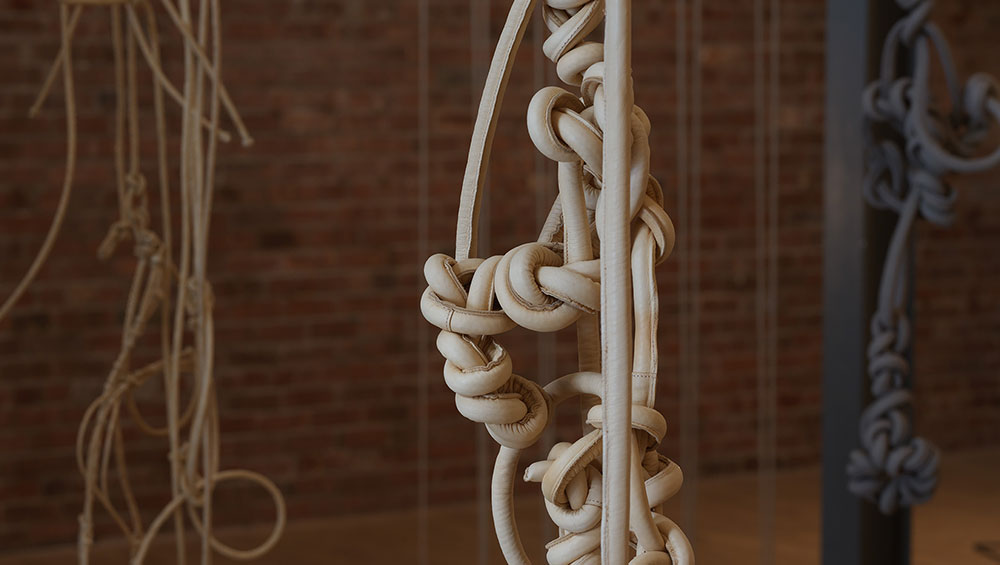
Leonor Antunes, Discrepancies with M.S. #5 (detail), 2020. Courtesy the artist, kurimanzutto, Mexico City/New York. Photo: Nick Ash.
Fruitmarket (part of Edinburgh Art Festival 2023)
24 June – 8 October 2023
by BETH WILLIAMSON
The forms and materials of sculpture employed by the Portuguese-born, Berlin-based artist Leonor Antunes (b1972) gesture to the overlooked, sometimes hidden histories of modernism, often involving female artists and designers. Bringing together architecture, design and craft, she combines materials such as cork, linoleum, bamboo, leather, wood, rope and brass in ways that obliquely reference these overlooked 20th-century practitioners. In 2017-18, she was commissioned to make work for the Whitechapel Gallery in London in an exhibition titled The Frisson of the Togetherness, a phrase used by the British architect Alison Smithson (1928-93) to describe how young people define themselves through style, identity and social allegiances. On that occasion, Antunes was interested in the work of the London-based sculptors Mary Martin (1907-69) and Lucia Nogueira (1950-98). For the Portuguese representation at the 58th Venice Biennale in 2019, the materials and formats in Antunes’ A Seam, a Surface, a Hinge, Or a Knot in the Portuguese Pavilion gestured to her interest in the memory of the Italian architect Carlo Scarpa (1906-78). The then Portuguese minister of culture, Graça Fonseca, said: “The presence of her sculptures [in the exhibition space] … is a gesture that accompanies us in filling the void that exists between the sculpture and its setting.”
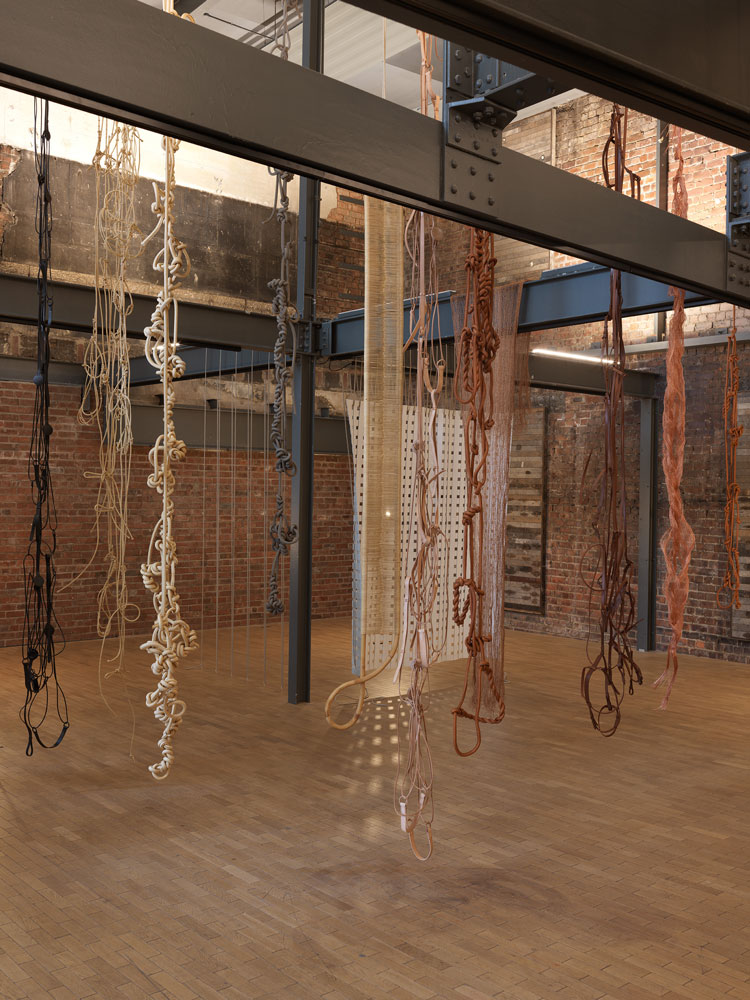
Leonor Antunes, The Apparent Length of a Floor Area, installation view, Fruitmarket, Edinburgh, 2023. Courtesy the artist, kurimanzutto, Mexico City / New York and Marian Goodman Gallery. Photo: Nick Ash.
The rather poetic idea of a sculptural presence filling a void between itself and its setting is made manifest, at least in part, in The Apparent Length of a Floor Area, Antunes’ present exhibition at the Fruitmarket. The exhibition, part of Edinburgh Art Festival 2023, is installed across all three spaces of the gallery. Entering the clean white space of the downstairs gallery involves crossing a threshold where the usual flooring is replaced by Antunes’ cork and linoleum floor covering. This change in materials underfoot marks a shift to something more domestic and homely in nature, which makes sense when you realise that the works installed here are from the artist’s series The Homemaker and Her Domain.
Large bamboo structures act as a support for suspended works in a variety of materials, including cherry wood, rope, brass, silk, leather, nylon yarn, straw and Piñatex (a leather alternative made from pineapple). As the exhibition leaflet explains, the bamboo structures have the feel of a temporary shelter, or a modern exhibition stand displaying materials, forms and techniques. I agree, although in the sterile white gallery spaces, these temporary shelters are experienced more as objects to be observed and thought about, rather than welcoming spaces of safety to be entered into.
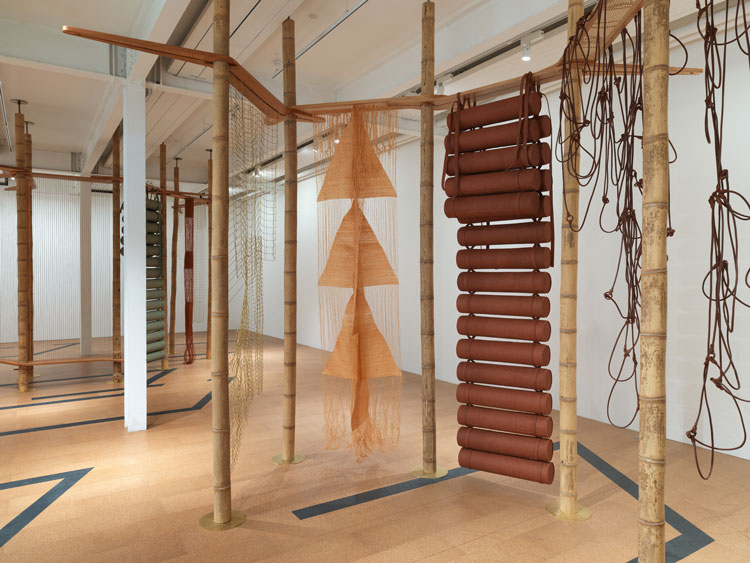
Leonor Antunes, The homemaker and her domain II, 2022. Installation view, Fruitmarket, Edinburgh, 2023. Courtesy the artist, kurimanzutto, Mexico City / New York and Marian Goodman Gallery. Photo: Nick Ash.
The hanging elements of the sculptures allude to the female designers Antunes has used as her reference points for these works – the French architect and designer Charlotte Perriand (1903-99) and the weavers Lena Bergner (1906-81), Trude Guermonprez (1910-76) and Michiko Yamawaki (1910-2000). Bergner attended the Bauhaus (1926-29) before spending time in the Soviet Union and Mexico. Yamawaki attended for two years (1930-32) before returning to Japan. Guermonprez left Germany to teach at Black Mountain College in North Carolina in the 1940s.These transnational tales of modern female practitioners (referenced through their first names, formats and materials) become stand-ins for their often-marginalised craft practices. Antunes’ references are sympathetically made, coalescing in a space that becomes a home for marginalised and displaced crafts, materials and people.
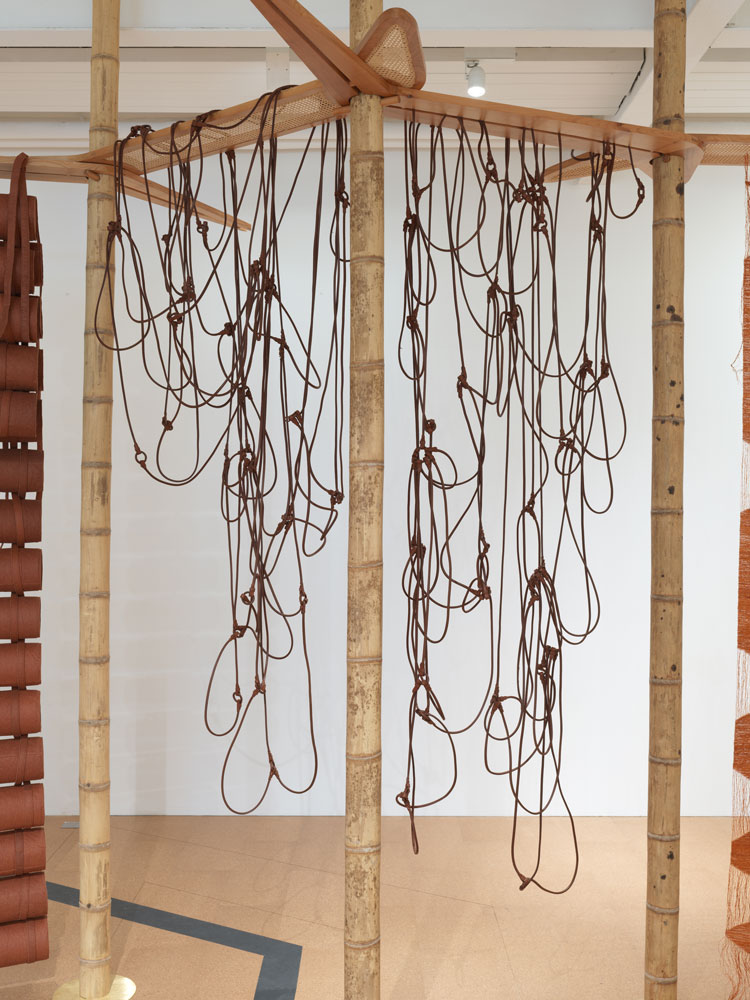
Leonor Antunes, The homemaker and her domain II, 2022. Installation view, Fruitmarket, Edinburgh, 2023. Courtesy the artist, kurimanzutto, Mexico City / New York and Marian Goodman Gallery. Photo: Nick Ash.
In the upstairs gallery, there is an economy of means that encourages us to focus attention more acutely still on objects, and maintains and underlines the void of which Fonseca spoke. The hanging sculptures here are much sparer in their configurations – a delicate metal net with tiny, linked rods is, we are told, reminiscent of Gego’s Reticuláreas of the 1960s, although it is based on a design for weaving by Bergner. Here, though, the grid dissolves into a net before appearing to disappear entirely, were it were not for glints of reflected light indicating its presence in the space.
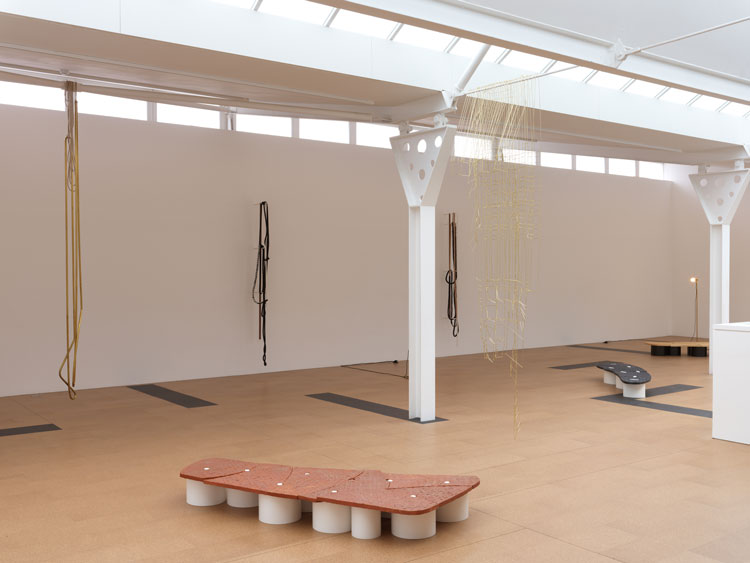
Leonor Antunes, The Apparent Length of a Floor Area, installation view, Fruitmarket, Edinburgh, 2023. Courtesy the artist, kurimanzutto, Mexico City / New York and Marian Goodman Gallery. Photo: Nick Ash.
At floor-level, low tables called Charlottes (based on a Perriand design) have a ceramic surface that holds the imprint of a Mexican rush mat. The floor itself is, as in the downstairs gallery, entirely covered in cork and linoleum designed by Antunes, but based on rug designs by the British designer Marian Pepler (1904-97), who worked for Gordon Russell Ltd and had many of her rugs made by Edinburgh Weavers, a local connection with Antunes’ work for this exhibition. In another local connection, during her exhibition preparations, Antunes became interested in the 1938 architect-designed modernist house of Alastair Morton, then artistic director of Edinburgh Weavers, which included several cork floors. The cleanliness and efficiency for which materials such as cork and lino were valued in modernist design is echoed here in this sparse white upstairs space, cool, balanced and neutral.
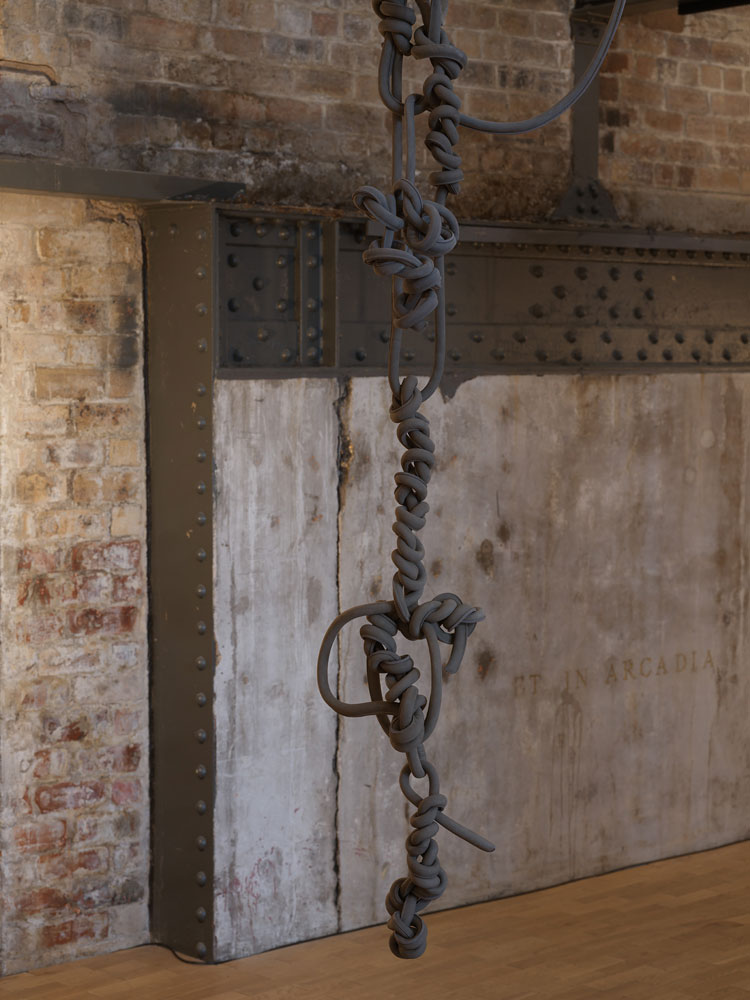
Leonor Antunes, Discrepancies with M.S. #9 (detail), 2020. Courtesy of the artist and Kurimanzutto, Mexico City / New York. Photo: Nick Ash.
What is interesting is how the works in the two white gallery spaces are experienced very differently from those in the Warehouse space. This dimly lit, cavernous space is characterised by its unfinished, exposed brickwork, black steel supports and crossbeams, rough wooden screens and panels. Here, Antunes installs her Discrepancies works and others – ropes of leather, hemp and cotton. She creates further open-weave screens of sorts by weaving rope and other materials between the floor and the overhead steel beams. Tying spaces together in this way, along with the feeling of warmth and relative safety that comes from the presence of natural materials and dimmed lighting, creates a space of connection, a sense of being part of these forms, linked to material and method in a continuum that stretches back to histories we may never have known. Now we are tied organically to these histories by ropes that tumble, cascade and bind.
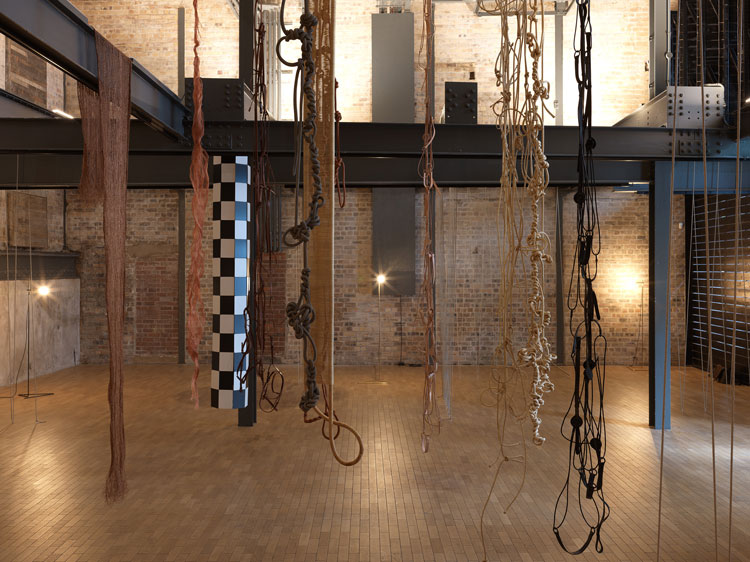
Leonor Antunes, The Apparent Length of a Floor Area, installation view, Fruitmarket, Edinburgh, 2023. Courtesy the artist, kurimanzutto, Mexico City / New York and Marian Goodman Gallery. Photo: Nick Ash.
Pausing in this space, there is an invitation to listen, question, and better understand how we are fastened to these artists, designers and architects through Antunes’ enacting of craft methods with natural materials that link, loop and knot together with each other and, in a sense, with us too. Here the void between the sculptural presence and its setting is filled.